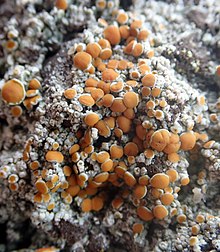| Caloplaca | |
|---|---|

| |
| Caloplaca maculata | |
| Scientific classification | |
| Domain: | Eukaryota |
| Kingdom: | Fungi |
| Division: | Ascomycota |
| Class: | Lecanoromycetes |
| Order: | Teloschistales |
| Family: | Teloschistaceae |
| Genus: | Caloplaca Th.Fr. (1860) |
| Type species | |
| Caloplaca cerina | |
| Species | |
Caloplaca is a lichen genus[1] comprising a number of distinct species. Members of the genus are commonly called firedot lichen,[2]: 235 jewel lichen.[2]: 235 gold lichens, "orange lichens",[3][4] but they are not always orange, as in the case of C. albovariegata.[5] The distribution of this lichen genus is worldwide, extending from Antarctica[6] to the high Arctic.[7] It includes a portion of northern North America and the Russian High Arctic. There are about thirty species of Caloplaca in the flora of the British Isles.[8]
A new species of Caloplaca, C. obamae, the first species to be named in honor of Barack Obama, was discovered in 2007 on Santa Rosa Island in California and published in March 2009.[9]
Taxonomy[edit]
Caloplaca was circumscribed in 1860 by Theodor Magnus Fries.[10]
Until relatively recently, Caloplaca was one of the largest genera of lichen-forming fungi, with more than 500 species.[11] Since the advent of molecular phylogenetics, the formerly polyphyletic genus has been split into more than 30 smaller, monophyletic genera after many publications by Ukrainian lichenologist Sergey Kondratyuk and colleagues.[12][13][14][15]
List of species[edit]
Gallery[edit]
References[edit]
- ^ Brodo, Irwin M.; Sharnoff, Sylvia Duran; Sharnoff, Stephen; Laurie-Bourque, Susan (2001). Lichens of North America (1st ed.). Yale University Press. ISBN 978-0-300-08249-4.
- ^ a b Field Guide to California Lichens, Stephen Sharnoff, Yale University Press, 2014, ISBN 978-0-300-19500-2
- ^ USDA Natural Resources Conservation Service Name Search
- ^ Orange Lichen (Caloplaca), Encyclopedia of Life
- ^ Plants Profile for Caloplaca (orange lichen), USDA
- ^ Olech, M. (1993). "Four new species of Caloplaca from Antarctica". The Lichenologist. 25 (3): 261–269. doi:10.1006/lich.1993.1030. S2CID 85428829.
- ^ Søchting, U.; Olech‡, M. (2007). "The lichen genus Caloplaca in polar regions". The Lichenologist. 27 (6): 463. doi:10.1017/S0024282995000594.
- ^ Dobson, F.S. (2000). Lichens, an illustrated guide to the British and Irish species (4th ed.). Slough, England: Richmond. ISBN 978-0-85546-315-1.
- ^ "New Species Of Lichen Named After President Barack Obama". ScienceDaily. 16 April 2009. Retrieved 16 April 2009.
- ^ Fries, T.M. (1860). Lichenes Arctoi Europae Groenlandiaeque hactenus cogniti. p. 218.
- ^ Kirk, Paul M.; Cannon, Paul F.; Minter, David W.; Stalpers, Joost A., eds. (2008). Dictionary of the Fungi. Vol. 10. CAB International. p. 111. ISBN 978-1-84593-933-5.
- ^ Kondratyuk, S.Y.; Jeong, M.-H.; Yu, N.-N.; Kärnefelt, I.; Thell, A.; Elix, J.A.; Kim, J.; Kondratiuk, A.S.; Hur, J.-S. (2014). "A revised taxonomy for the subfamily Caloplacoideae (Teloschistaceae, Ascomycota) based on molecular phylogeny". Acta Botanica Hungarica. 56 (1–2): 93–123. doi:10.1556/abot.56.2014.1-2.10.
- ^ Kondratyuk, S.Y.; Lőkös, L.; J.A., Kim; Kondratiuk, A.S.; Jeong, M.H.; Jang, S.H.; Oh, S.O.; Hur, J.S. (2015). "Three new monotypic genera of the caloplacoid lichens (Teloschistaceae, lichen-forming ascomycetes)". Mycobiology. 43 (3): 195–202. doi:10.5941/MYCO.2015.43.3.195. PMC 4630424. PMID 26539034.
- ^ Kondratyuk, S.Y.; Persson, P.E.; Hansson, M.; Mishra, G.K.; Nayaka, S.; Liu, D.; Hur, J.S.; Thell, A. (2018). "Upretia, a new caloplacoid lichen genus (Teloschistaceae, lichen-forming Ascomycota) from India". Cryptogam Biodiversity and Assessment. S2018: 22–31. doi:10.21756/CAB.ESP5.
- ^ Kondratyuk, S.Y.; Lőkös, L.; Farkas, E.; Kärnefelt, I.; Thell, A.; Yamamoto, Y.; Hur, J.-S. (2020). "Three new genera of the Teloschistaceae proved by three gene phylogeny" (PDF). Acta Botanica Hungarica. 62 (1–2): 109–136. doi:10.1556/034.62.2020.1-2.7. S2CID 226056287.
